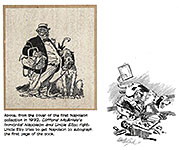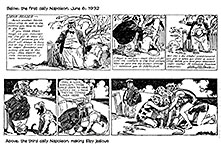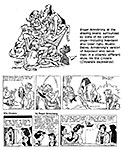When a Dog
Was Art
Clifford
McBride and the Immortal Napoleon
Back in those
dear, dead days of yesteryear, cartoonists drew comic strips; they
didn’t rule them with a straight-edge. And one of the best examples of
the truth of this freshly brewed axiom is Clifford McBride’s dog strip, Napoleon. McBride drew with great verve and an exuberant pen, producing
such a ferociously kinetic line that even when depicted in repose, his subjects
seemed vitally energetic. And the style suited the subject (in fact, given the
low-key humor of the strip, the style may have been the subject).
The
strip focused on a stout bachelor and his giant pet—Uncle Elby and
Napoleon—achieving, as art critic Dennis Wepman once wrote in Ron Goulart’s Encyclopedia
of American Comics,, a “beautifully balanced team—the fat man, all stasis
and order, and the lean dog, all motion and chaos.”  It is Elby’s fate (and the flywheel of
the strip’s punchline, daily and Sunday) to be forever dogged (pun intended) by
misfortune of a minor dimension: if his own bumbling doesn’t frustrate his
plans that day, then the clumsy albeit good-hearted meddling of his
affectionate, over-sized hound does. It is Elby’s fate (and the flywheel of
the strip’s punchline, daily and Sunday) to be forever dogged (pun intended) by
misfortune of a minor dimension: if his own bumbling doesn’t frustrate his
plans that day, then the clumsy albeit good-hearted meddling of his
affectionate, over-sized hound does.
Elby
was patterned visually after McBride’s uncle, Henry Elba Eastman, a Wisconsin
lumberman. McBride was likewise an upper midwesterner, born January 25 (or
26),1901 in
Minneapolis,
Minnesota, the son of a purchasing agent for a threshing machine company (who
identified himself on his son's birth certificate by writing "They just
call me 'Mr. McBride'") and Lillian Eastman McBride, housewife. The family
moved to Pasadena, California, when Clifford was nine. He drew throughout his
school years, and he was twice expelled (then reinstated) from Pasadena High
School for his cartoons in the school newspaper. When he was sixteen, he sold
an editorial cartoon to the Los Angeles Times. He graduated from
Occidental College in 1923 and joined the art department at the Times, producing a series of pantomime comic strips. In 1924, he left for the Chicago
Tribune, where he illustrated humorous fiction for the paper and its
magazine, Liberty. The next year, he accepted an offer from McNaught
Syndicate to distribute nationally a full-page weekly pantomime comic strip,
and McBride returned to Pasadena.
Offered
in black-and-white for release on either Saturday or Sunday, the McNaught
feature was a miscellany page: instead of a continuing title, it carried a
descriptive headline that changed every week to suit that week’s subject.
Napoleon showed up in one of these, either in the fall of 1927 or in the spring
of 1929. The confusion, which I’ll clear up in a trice, exists because my
sources contradict each other.
One
source, the Hyperion Library of Classic American Comic Strips, which, in 1977,
published the daily Napoleon from its start on June 6, 1932, reprints
three of the McNaught weekend pages in the introductory pages. And these are
dated, by the series editor Bill Blackbeard, November 20, 1927, April 28, 1929,
and May 5, 1929. My other source came from cartoonist Roger Armstrong, who
inherited the strip after McBride’s death in 1951—copies of syndicate proof
pages, some of which are reproduced in this vicinity. Blackbeard’s dates are
wrong, but it’s not his fault.
The
page that is dated April 28, 1929 in the Hyperion book is dated Saturday, April
20 or Sunday, April 21, 1929 on the proof page; Hyperion’s May 5 strip is dated
Saturday, April 13 or Sunday, April 14 on the proof page. The discrepancy in
the dates is easily explained: the Hyperion dates were determined by the date
of the strips’ publication in the Los Angeles Times, Blackbeard’s only
source at the time. The Times clearly published the pages later than the
dates McNaught suggested on its proof pages—and out of order.
The
proof versions of both of these pages are reproduced nearby, and it would seem,
from the context (Uncle Elby is clearly buying a dog in “Lonesome Pup”), that
the April 13/14 page marks the debut of the out-sized mutt, not the page
recording Elby’s attempt to “launder” the animal, even though, in the Times, the laundering page appeared first on April 28.
As
for Napoleon’s supposed earlier appearance on Blackbeard’s November 1927 page
(entitled “The Sentimental Picnicker and the Hungry Dog”), while the portly
Picnicker is probably the character who subsequently was named Uncle Elby, the
dog was probably not the dog subsquently named Napoleon. Both animals are large
lumbering canines, but the 1927 dog has no dark patch on its back. (The merest
of cavils, I admit; but history is made of quibbles like this.) McBride’s sense
of humor betrayed a penchant for hilarities involving large animals and fat
men, and that tendency began to emerge with the November 1927 page, but more
than that, we cannot say with absolutely certainty.
The
large and clumsy canine was eventually christened Napoleon, probably because of
his owner's name, Elby, which, as Blackbeard acutely reports in the World
Encyclopedia of Comics, evoked the deposed French emperor with the
resonance of the site of his exile, Elba Island. McBride's drawings of the dog
attracted the attention of a newspaper feature syndicate salesman, Arthur J.
Lafave, who persuaded McBride to let him market a daily comic strip about the
enthusiastic dog and his inept owner. The daily Napoleon and Uncle Elby debuted in June 1932, and a Sunday version appeared March 12, 1933.  Lafave secured enough
subscribing newspapers to establish his own syndicate, a legend in the industry
because it was founded on a single feature, McBride's comic strip. Lafave secured enough
subscribing newspapers to establish his own syndicate, a legend in the industry
because it was founded on a single feature, McBride's comic strip.
At
the very introduction of the gaunt Irish wolfhound, as we’ve witnessed, McBride
established the comedic pattern the strip would follow often in ensuing years.
After buying the dog, Elby builds a doghouse for it, but the animal is lonely
at night in this domicile, so he invades his master's bedroom. Tugging the
blanket on the bed, Napoleon awakens Elby and climbs into bed with him, taking
all the covers and displacing his owner. Elby can't get the dog out of bed, so
he retires to the dubious comforts of the doghouse outside.
The
comedy is usually highly physical as it must be in pantomime. And Elby is a
champion bumbler on his own, without any help from Napoleon, as we can see in
an unusual two-parter done for the old humor magazine, Life, wherein
Napoleon’s affectionate enthusiasm destroys Elby’s fishing plans.
On
another fishing expedition, Napoleon is, again, left ashore but swims out to
Elby in the boat; Elby returns the dog to the shore and ties him to the
doghouse. The huge animal, nothing if not persistent, swims out to Elby again,
towing the doghouse behind him. He climbs into the boat, capsizing it. The last
panel shows Elby seated on the floating doghouse, Napoleon snuggled up
wistfully beside him.
Most
of the time, McBride's humor was achieved in pantomime, but occasionally, he
resorted to short speeches. In a daily strip, Elby sits, exhausted, on a pile
of logs he's just cut for the fireplace, and he says to Napoleon, "All
right—I sawed it. You carry it in." The obedient dog takes in his mouth a
log at the bottom of the pile, causing the entire edifice, Elby included, to
collapse.
“I
saw Napoleon when it started in the Los Angeles Times,” Roger
Armstrong remembered, “and I thought it was one of the most wonderful things
I’d ever seen.”
When
he found out that McBride lived in Altadena on New York Avenue, he resolved to
meet the cartoonist. With a bundle of his own drawings under his arm, he
knocked on McBride’s front door.
“He
was very gracious,” Armstrong told me. “And so I went to see him every so
often. He moved from the New York Avenue place to the foothills. He had a
little house that was separate from the main house, and that was his studio. He
was an accomplished pianist, by the way, and he had a concert grand piano in
there.
“Well,
I haunted the poor man,” he continued. “I’d go and lurk by his side and watch
him draw, and he was very, very kind to me. Sometimes I’d have dinner over
there. That’s where I found out you could have spaghetti served to you by a
Japanese house boy. And Clifford showed me what pen he used—a Gillott 290 [the
fabled nib of most old masters of the pen]—and all this stuff, and bit by bit,
he let me do a little on the strip—simple backgrounds—and he let me do his
lettering.”
I
asked if McBride drew rapidly. “That marvelously sketchy style,” I said, “—you
couldn’t get the effect of such breezy abandon by drawing slowly, I wouldn’t
think.”
“Oh,
no,” Armstrong said. “Clifford was so fast. The guy was incredible. A little
known fact about Clifford is that when he pencilled the strip, he did not
pencil it loosely. He pencilled it in exactly the detail that you see the final
pen-and-ink work. It was unbelievable. I mean, he did every single bit—all the
shading and everything—with the pencil before he went in to it with a pen, and
he grabbed the pen way out at the end of the pen holder—far away from the pen
point—and he used to ink that way. The control he had was absolutely unreal. He
knew exactly what it was going to do—where it was going—and he put it down. Not
that he inked every pencil line as it had been drawn. He didn’t. He was very
fast. He developed tremendous speed and freedom of line, and, of course, I did,
too, watching him. And that’s the way I draw: I grab the pencil way out by the
eraser. And I ink that way, too. And I paint watercolors the same way. And I
tell my students, Don’t grab it way down at the end where you’ll get ink all
over your fingers. Grab it as far back as you can conveniently control it.”
Armstrong
sometimes helped McBride with his jigsaw puzzle.
“He
was a great one for re-using old strips,” Armstrong said. “He’d cut his
original strips into pieces and put them into an envelope, and then if he
needed to put together some stuff in a hurry, he’d shake it all out and piece
the panels together in a new arrangement. So he’d have me cut and paste
sometimes, and he’d let me do the extra drawing in the backgrounds to fit the
pieces together.”
The
visits to McBride’s studio continued through Armstrong’s high school and
college years. The cartoonist, Armstrong said, pursued athletic hobbies (boat
racing and swimming) as well as performing magic. He and his first wife,
Elizabeth, had two children, a boy and a girl, before their divorce in the
1940s. McBride died of a heart attack while in the hospital being treated for
prostate cancer, and his second wife, Margot Cuppet Fischer, who had worked on
a student newspaper with Armstrong in an earlier life, remembered that
Armstrong had helped on Napoleon and asked him to continue it.
Armstrong
did just that. And at the same time, he was also drawing Ella Cinders.
Noting that no two strips with more disparate drawing styles could be imagined,
I asked him how he managed it. 
“No
wonder I’m schizophrenic,” he laughed. “Seriously, I just changed hats in the
middle of the week, changed my philosophical approach, my attitude about
inking, for instance. Ella was done very meticulously, as if it was
carved out with a wire, whereas Napoleon was fast, fast, fast. The only
thing I can say is that I just changed—right in the middle of the week. I spent
half the week on one; half on the other.”
The
worlds occupied by Ella and by Napoleon were as different as the drawing
styles.
“The
world of Napoleon,” Armstrong said, “was not a real world in the sense that it
had any depth. Berrydale, which is where Uncle Elby lived, was a very ephemeral
concept. Ella moved in a much more real world. In Napoleon, we were
aware of people in the world there, but they did not constitute in my mind a
real world. Berrydale was a fantasy.”
I
agreed: “Every time I read a Napoleon strip,” I said, “I feel as if I am
looking through a kind of gauze screen and seeing a bright, hot, humid August
afternoon where you can hear the faint buzzing of some kind of insect in the
trees and all other sound seems distant and muffled, and nothing really moves
around very fast. A dream world, a languorous summer afternoon sort of
place—somnolent, relaxing. Not real at all.”
According
to Allan Holtz’s American Newspaper Comics: An Encyclopedic Reference Guide, Lafave had trained Art Heinemann to take over after McBride. Holtz says
Margot McBride “supplied ideas for several years.” She seems to have inherited Napoleon, becoming the strip’s managing director. Presumably, she hired Armstrong
when she changed syndicates, leaving Lafave for Mirror Enterprises; Armstrong
never mentioned Heinemann (as far as I can remember). Holtz also says that Joe
Messerli and Mort Taylor assisted Armstrong on art. Armstrong mentioned
Messerli but not Taylor.
If
Uncle Elby was McBride’s actual uncle, Napoleon was, ostensibly (according to
syndicate publicity), the cartoonist’s dog, a St. Bernard. But in rendering the
animal, McBride took a few pounds off, I’d say, and the final result looked
more like an Irish wolfhound than a St. Bernard.
The
strip ended sometime in 1960, having, for almost 30 years, provided an endless
variation on its paean to a master-victim and his nemesis. Said Wepman:
“Napoleon
was an undisciplined and undisciplinable creature whose slightest impulse
created chaos in the prim life of his owner ... [whose] efforts at maintaining
order in his tidy bachelor life were perennially defeated. Napoleon’s motives
were always innocent, and often noble; but the irrepressible force behind them
inevitably resulted in Uncle Elby’s embarrassment, arrest, or financial loss,
with something always broken or buried or dug up along the way.”
Napoleon appeared in the comics before cartoonists had made an accepted convention of
talking animals in strips that also featured humans, but the big lumbering dog
needed no words: in a triumph of visual style, McBride made the dog's face
talk, giving it a range of humanoid expression that spoke comedic volumes.
Posted
nearby is a classic example that McBride used more than once. Elby is speaking
into the telephone: "You say you're going to drop past with a package of nice
bones for Napoleon?" The dog, hearing this, beams with anticipation, and
the remainder of the strip focuses on his face, which changes expression as
Elby continues the conversation: "Well, that's mighty thoughtful of
you," he says; "he'd, naturally, be delighted, but—" Napoleon is
suddenly alarmed, ears flapping "—I couldn't think of allowing you to go
so far out of your way. Better give them to some neighbor's dog. Thanks again
for thinking of him." Napoleon scowls at us, his face almost human in
displaying his angry disappointment.
Many
of the gags feature Napoleon by himself, wandering the neighborhood of
McBride's idyllic Berrydale. Napoleon climbs into a garbage barrel, upsetting
it, and it rolls down the hill with the dog still inside. He chases a rabbit
into a culvert; the rabbit exits at the far end, but Napoleon fiercely waits
for the creature to re-emerge on the end he entered. The dog stays there until
nightfall, his expression no longer fierce but puzzled and sad.
The
comic strip has been reprinted several times: Clifford McBride's Immortal
Napoleon and Uncle Elby, 1932; Napoleon and Uncle Elby, 1938 (and
with the same title in 1945); Napoleon and Uncle Elby and Little Mary, 1939; and Napoleon: A Complete Compilation, 1932-1933, 1977. A motion
picture with live action characters was reportedly produced in 1941 Although he
died at a relatively early age, McBride earned a permanent place in the
pantheon of newspaper cartoonists with his distinctive style. And in
remembering McBride’s energetic line, we cannot help but recall also the dog’s
vociferous visage.
Before
we go, here are a few more images of the immortal Napoleon, including some from
the McNaught miscellany years and from the early months of Lafave’s syndicated
daily.
Return to Harv's Hindsights |